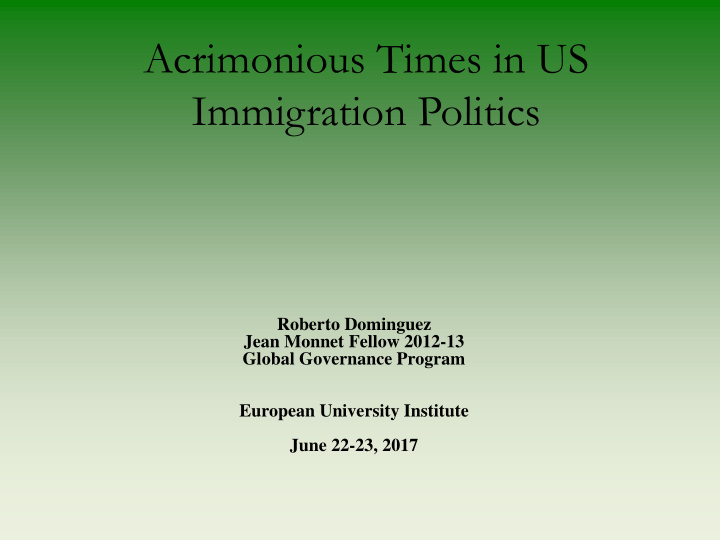



Acrimonious Times in US Immigration Politics Roberto Dominguez Jean Monnet Fellow 2012-13 Global Governance Program European University Institute June 22-23, 2017
EUI-Network • 2014 Humanitarian Crisis of 50,000 unaccompanied children arriving in the US • Externalization of borders (Zaiotti, 2016) • Obama requested 3.7 billion and received less than one. • Obama: “Deporter” in Chief • IRCA in 1986-Piecemeal approach
Securitization: Framework for Facilitating analysis Conditions Securitization /De- Speech Acts securitization Audiences
Halfway Securitization of Immigration in the United States Facilitating Conditions Institutional Speech Acts Transformations ? Halfway Securitizati Audiences on
Facilitating Conditions
Facilitating Conditions • Roaring twenties, economic prosperity with a distinctive cultural edge – Warren Harding: 1921 Per Centum Act – Calvin Coolidge: 1925-national-origin quotas • The U.S. economy grew by an average of 3.8% from 1946 to 1973 – The Immigration and Naturalization Act of 1965, based on reuniting immigrant families and attracting skilled labor to the United States
Facilitating Conditions 2016-17 • Is this Time Different? Structural Trends Junctural /Accidental Trump’s direct and short messages in Low unemployment (less 5%) campaign Secular stagnation (1.3% annual economic growth). Catharsis to a sense of disempowerment after two administrations of an African American Growing downward pressures on the West’s president middle classes (wrought by the snowballing forces of globalization and automation) Unappealing Democrat Party candidate Fatigue with two- party system and outsider’s Hackings of sensitive information perspectives Public investigations in sensitive electoral timing.
The material component of Speech Acts
Immigration as a Threat • Rapist (Hispanic/Mexican) and Terrorists (Muslims) • Ideas were waiting for implementation – Buchannan: Cultural argument — North American Kosovo – Malkin: National Security argument • Common method for argumentation: Cases as general trends
Hispanic/Muslim Community in US
Immigrant Threats 9-11 to 2016 Terrorism is statistically a very minor problem in the USA – 45 people have been killed in the United States by jihadi terrorists – 48 have been killed by people animated by anti-abortion, neo- Nazi, anti-government fanaticism. – Most of lethal terrorist attack in the United States since 9/11 have been conducted by American citizens or legal permanent residents. • No-fly list: 16 people on 9/11; 47,000 in 2017. • 3,000 or 5,000 times more likely to be killed a fellow American. • In 2013 non-Hispanic black males accounted for 37% of the total male prison population, non-Hispanic whites 32%, and Hispanic males 22%.
Fragmented Audience(s)
Fragmented Audience Traditional voices: Malkin-Buchanan-Coulter Systematic pressure groups: FAIR, NUMBERSUSA, and CIS Trump’s voters: College educated white voters by a four-point margin over Hillary Clinton White working class, twice the number of votes over for Clinton. Anxiety about cultural change: 68 percent Immigrants as threat to culture: 62 percent Deporting immigrants: 27 percent Investing in education is risky: 54 percent
Fragmented Audience • Three more million votes for Clinton/Democrats • Moderate immigration policies (Jeb Bush style); GOP internal division • Apathy (Trump was not a joke) – African American turnout decline between 2012 and 2016 – Hispanic turnout identical to 2012
Contestation of Policy Making Halfway Securitization
Contestation and Reversing of Policies Immigration Area Contestation/Reversing Muslim Ban Ninth Circuit Court of Appeals (June 12) rule against the implementation of the EO Wall It is already built in high traffic areas and some technology is already implemented. 2006 Secure Fence Act; Solar Wall; drugs interdictions have gradually decreased Sanctuary Cities 300 jurisdictions Justice Department has sent requests to explain status VOICE (Victims) Does not alter immigration policies DREAM Act/DACA President Trump extended DACA Immigration Reform Unlikely after political cost of repealing Obamacare
Final Thoughts • Still too early • The securitization process is halfway and may be reversed • Unconvincing narratives • Fragmented audiences • Contestations and concessions • Multiple actors: courts, cities, lawmakers, late reactions of affected groups
Recommend
More recommend